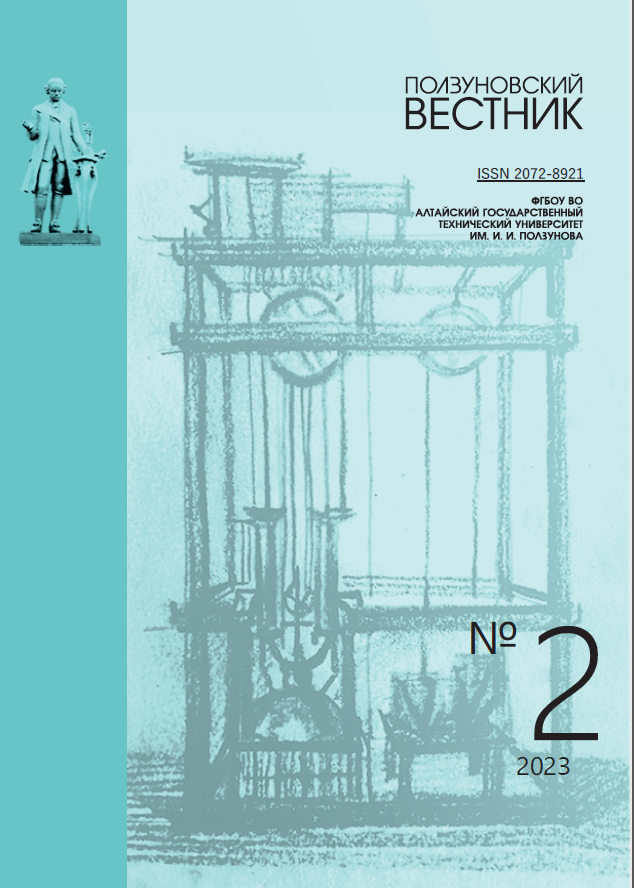PHYTOREMEDIATION AS A PROMISING METHOD OF SOIL PURIFICATION FROM HEAVY METALS
GXGPPD
DOI:
https://doi.org/10.25712/ASTU.2072-8921.2023.02.021Keywords:
phytoremediation, biomass, agricultural land, polluted soils, heavy metals, cadmium, lead, oats, sow-ing soil reclamation, gravimetry, biometricsAbstract
Human economic activity entails some danger to the environment, including the formation and devel-opment of vegetation cover. Heavy metals that can reduce the growth rate of plant biomass enter the soil, water bodies through human activities, the work of metallurgical and energy enterprises, road transport, and the use of fertilizers. Often there is a suppression of the vegetation cover up to its complete disappearance. In particular, the soils of agricultural lands of the Altai Territory are subject to contamination with heavy metals, which largely affects the quantity and quality of agricultural products. There is a need to find and test effective ways to clean soils from heavy metals. One of these methods is phytoremediation, which allows for land reclamation and restores their productivity. The present work involves two stages. At the first stage, the response of the oat plant to the pres-ence of pollutants in the soil is studied. At the second stage, it is planned to study the phytoaccumulation of lead and cadmium pollutants in the plant biomass and to identify the possibility of using oat phytoremediation in the technology of soil reclamation of agricultural lands in the Altai Territory. Gravity and biometrics of plants were used as methods of analysis. A positive response of oats to the presence of cadmium in the soil in concentrations exceeding the MPC was established, which made it possible to recommend the use of oats as a potential phytoremediator for the second stage of plant studies on an atomic absorption spectrometer
References
Ежегодник. Загрязнение почв Российской Федерации токсикантами промышленного происхождения в 2021 году. Обнинск : ФГБУ «НПО «Тайфун», 2022. 131 c.
Фиторемедиация технонарушенных территорий / Э.М. Зайнутдинова, Г.Г. Ягафарова, Е.А. Шамсудинова, А.К. Мазитова // Вестник Казанского технологического университета. 2017. № 6. С. 157–159.
Андреева И.В. Фиторемедиация почв, за-грязненных тяжелыми металлами // Природообустройство. 2009. № 5. С. 7.
Добровольский В.В. Глобальная система массопотоков тяжелых металлов в биосфере // Рассеянные элементы в бореальных лесах. М. : Наука, 2004. С. 23–30.
Ильин В.Б. Тяжелые металлы и неметаллы в системе почва – растение. Новосибирск : СО РАН, 2012. 220 с.
Башмаков Д.И. Особенности адаптации к тяжелым металлам у растений из разных жизненных форм и экологических групп // ИВУЗ ПР Естественные науки. 2022. № 2 (38). С. 59–68.
Титов А.Ф., Таланова В.В., Казнина Н.М., Лайдинен Г.Ф. Устойчивость растений к тяжелым металлам. Институт биологии КарНЦ РАН. Петрозаводск: Карельский научный центр РАН, 2007. 172 с.
Титов А.Ф., Казнина Н.М., Таланова В.В. Тяжелые металлы и растения. Петрозаводск : Карельский научный центр РАН, 2014. 194 с.
Rascio N. NavariIzzo F. (2011). Heavy metal hyperaccumulating plants: how and why do they do it? And what makes them so interesting? Plant Science. 81.
Иванов В.Б., Быстрова Е.И., Серегин И.В. Сравнение влияния тяжелых металлов на рост корня в связи с проблемой специфичности и избирательности их действия // Физиология растений. 2003. Т. 50, № 3. С. 445–454.
Cлабко Ю.И., Лопатина А.А. Аккумуляция кадмия в почве и растениях сои под влиянием минеральных удобрений // Вестник КрасГАУ. 2016. № 2. С. 19–23.
Downloads
Published
How to Cite
Issue
Section
License
Copyright (c) 2023 Victoria V. Bauer, Olga Y. Sartakova, Olga M. Gorelova

This work is licensed under a Creative Commons Attribution 4.0 International License.















 .
. This work is licensed under a
This work is licensed under a 
